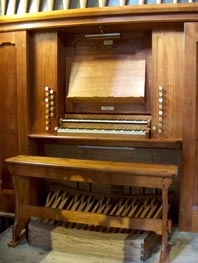
Events
Organ
|

By the year 2000 the instrument had fallen into disuse and needed substantial repair. In view of its considerable artistic significance the decision was taken to rebuild and in 2003 it was completely restored by Nicholson of Worcester in an appropriate historical manner. The original tracker action is in place, the refurbishment of the pipework carefully retained the original Willis voicing and the original pitch-pine finish of the casework and console was painstakingly reclaimed. Even the hand blowing equipment was restored to full working order. The only problem encountered was that the original Willis stool was inadequate for organ scholars (and Tutors) of varying shapes and sizes. Nicholson’s therefore made a brand new adjustable stool in pitch pine to match the console, whilst the original Willis stool was retained in the organ loft to provide additional seating and shelf space. Through its Founder, F.J.Chavasse, St Peter’s has strong links with Liverpool Anglican Cathedral and the Cathedral Organist, Professor Ian Tracey, gave the opening recital in September 2003 to great acclaim.
In spite of its modest size the organ has all the characteristic tonal vigour and subtlety of Willis’ larger instruments (e.g. Hereford, Salisbury and Truro Cathedrals): the great chorus is bright without being in any way strident, the flutes are clear and the swell fluework is topped by fiery reeds in the typical Willis fashion. The instrument is so skilfully voiced for the building that from the nave it gives the impression of being much larger than its modest tally of eighteen speaking stops. It is an ideal instrument for historically informed performance of the Anglican cathedral repertoire but is sufficiently versatile to cope with music from a wide variety of styles and periods.
THE ‘FATHER’ WILLIS ORGAN
St Peter’s College Chapel is fortunate in that it still possesses its original organ. ‘Father’ Henry Willis built it in 1875, just as he was rising to the height of his fame with instruments such as those for the Royal Albert Hall and the Alexandra Palace. It was subsequently slightly enlarged in 1889 by a local builder, Martin of Oxford, who added an open metal stop to the pedal division; otherwise, the quality and durability of Willis’s original craftsmanship ensured that it served the worship in the Church of St Peter le Bailey (subsequently St Peter’s College Chapel) for the next hundred years.
